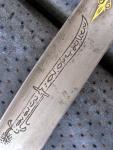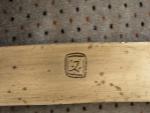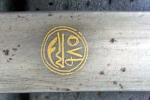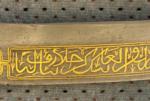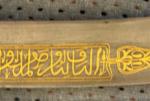-
Posts
4,862 -
Joined
-
Last visited
-
Days Won
15
Content Type
Profiles
Forums
Blogs
Gallery
Events
Store
Everything posted by peter monahan
-

Welch Wigs
peter monahan replied to Peter_Suciu's topic in Great Britain: Militaria: Badges, Uniforms & Equipment
Hang your head in shame, Chris! Well done, Jacaranda! "Welsh wig" was a new one on me, but I have a friend who actually makes Monmouth caps for his 19th century sailor impression. "A bit" of wool is the understatement of the year. One pulls 6"-8" strands of very thick wool through between, as far as i can tell< every other stitch on a knit cap. Think string mop on steroids! Think ghillie suit gone mad! Presumably waterproof, but a very scary sight, especially first thing in the am after an evening in the Mess! Peter -

Welch Wigs
peter monahan replied to Peter_Suciu's topic in Great Britain: Militaria: Badges, Uniforms & Equipment
Peter Your question is a touch vague. Do you mean wigs worn by the Welch Regiment ? Wigs made from Welch hair ? Wigs made in Wales? Something else entirely? Lots of us would be happy to try and help if we know what exactly you're looking for. (I think I can say that safely, can't I, Rick Research and all ?) The Welch Regiment, like the rest of the British Army, wore "queues" - hair pulled back into what today we'd call a "ponytail", with the hair powdered white with flour or talc. The Officers would have worn wigs - horse or human hair. Is that any help? Peter -
Pat Just looked again and saw the "broad arrow" mark on the pouch, so definitely NOT American. A broad arrow inside a "C" was the Canadian mark but I would not want to say absence of the "C" = British. Lots and lots and lots were made and used all over the Empire and who knows what weird and wonderful variations came out. The one thing you may be sure of, though, is that, stamped "1943" it saw use, not just "made up for stock" like so much of the post-war stuff. I'm not sure there is a book on Cdn webbing but I believe that someone did one for british stuff - maybe an Osprey series title? MCJ, can you help? Peter
-
Pat lawrence is correct: a British/Cdn pouch. The "British Empire Service League" officially changed it's name to the "Canadian Legion", (later Royal Canadian Legion) in 1948 throughunder a private bill in Parliament. I've always associated the copper BESL badges with World War I, not II, for no better reason than that I saw them most often and first with WWI medals. It's quite possible, maybe even probable, however, that the pattern was in use till 1948, covering WWII service as well. Nice "little" pieces in their own right: usually carefully made and in good shape because anyone who got/kept one treated it with respect. Well done, Garndpa! Peter
-
Ed Al Quaran would be my guess too, but I was hoping against hope that somebody out there is up on their monumental (right word?) Persian script, though an Armenian linguist friend once told me it's murder to decipher even for Arabic speakers. Also hoping that someone out there with esoteric tastes - the kind of guy, say, who'd collect Mongolian awards - would know of a source for blade markings on Eastern stuff. One lives in hope! Dan "If you can read this you are way too close! But not for long!" Yeah. or "If found please, please return to..." Peter
-
Dan I agree about the look - enough to make a guy collect enamelware. Pity about the names of the classes, though - must of bin thunk up by a civil servant ! "It's silver and gold so we'll call it the Silver and Gold Star. " Duh! Maybe not "knight", "commander" etc for an oriental award but something with class! Peter
-
On the back of the same blade are two other symbols/inscriptions which I suspect are maker's marks. On the blade, just "hiltward" of the fire-gilding is a smaller sword shaped inscription. Ideas on these? Sorry I didn't get a shot of the whole weapon. The blade is typical of the Turkish sword called a kinjal: single edged, drop point. The handle is plain black wood with two "ears" at the pommel end and the scabbard is also plain, which leads me to wonder if it has been re-hilted. Bought in Toronto 15 or 20 years ago, so no provenance. Any suggestions on how to research this item would be gratefully received. peter [attachmentid=54978] [attachmentid=54977] [attachmentid=54976]
-
[attachmentid=54974][attachmentid=54975] [attachmentid=54973] Does anyone out there know how/where I could get a translation of this inscription? ( from a Turkish "kinjal" blade) Thanks Peter
-
"Too soon old, too late smart!" When I googled "red Fokkers" I hit the discussion on "Flyboys" own website, on which the director, producer, camera man... and all their descendants are damned to the 7th ring of the Inferno for messing with history! I though I knew that there were no red squadrons. Apparently one of von Richtoffen's many aircraft was all red and scarlet at that. Also, the air buffs said: Jasta 9 used crossed swords, Jasta 11 used a "XI", so this film combines the two. Oh, well, another period massacred by Hollywood "dumbing down". In fact, one of the film's creators responds to the "all red BAD" comments by saying that (I paraphrase) "we were surprised but people couldn't tell the planes apart till we painted the Germans all red" and "Kurasaw did it with a [red army and a blue army] too." Shame! peter
-
After some not very flattering remarks about an upcoming flyinf flick - (see "Flyboys" under New Posts) I posed the following question. I wonder if this is the right place to repeat it? Question: which German staffel, if any, used crossed scimitars or falchions as a squadron marking? On further examination, the planes - Fokker Tripes and Biplanes, painted all red - appear to bear this insignia below the cockpits: Two black falchions (swords with blades wider at the point) crossed, hilts down, on a wide circle and between the sowrd tips the Roman numerals "XXI" . Not 100% sure on the numerals - stop action on a downloaded film clip. Suggestions?
-

Fake General Assault Badge 100 Engagements
peter monahan replied to a topic in Wehrmacht Medals, Decorations & Awards
War Lord I don't even collect these but am curious: can you tell us why this IS clearly a fake. And is it this one specimen or the whole badge or a run of fakes of a real award or...? Peter -
Nice stuff, Bear! Your book, by any chance? I have a chum who helped salvage some of Nappy's cannon off Acre who would be interested in this too. Peter
-
According to H. Tapprel Dorling's "Medals and Decorations" (p301), there were three "Fascist Medals" instituted by Mussolini. One was for the "march on Rome in October 1922", with a " half claret colour, half yellow ribbon." The second "was apparently awarded for long service in the Militia". Ribbon black with red, white & green edges." There was also a bronze badge for 10 yrs service. The third, the one you've asked about, "had a black ribbon with a central stripe of red, white and green, and small gilt stars were used on the star when worn alone to denote further periods of service." The illustration in the ribbon chart exactly matches Kev's posted pic.
-
Personally, I've always had a problem with the whole concept of "re-strikes. (BTW, I collected some badges 20 years ago when WWII stuff was just beginning to be faked). I make a crummy copy of a badge in my basement or bazaar and people say "Fake! Worthless.". So I make a good copy and people say "Reproduction! I'll give you $10.00". So then I make a good copy and call it a "re-strike from original dies". This suggests that it is in some way official or semi-officail and therefore almost as good as an original. And i sell it for lots of bucks! But lets examine that idea carefully: companies contracted to a government (army) or that gov't themselves decide, for reasons unexplained, to make more of an obsolete issue item and then, also for reasons unexplained, allow them to reach the civilian market. Does this sound plausible? If they are still official issue items then they're not re-strikes but "late issue originals" (I just made that up, BTW. ). And if they're not in offical use, why would notoriusly thrifty and secretive quartermaster types allow such dies to be used for re-strikes? Sounds fishy to me! Finally, if a "re-strike" is a badge made from same original die (and material) as one issued and worn in World War Two or whenever, then there IS no way to distinguish: it essentially the same badge! And after some clever clogs has banged it about and buffed and scratched it to simulate wear you will not be able to tell an "original" from a "re-strike/late issue original." Me, I figure "re-strike" is a fancy word for "good copy" or "fake". My tuppence worth Peter
-
Never mind the sword, tell us about Granny's gun cabinet!
-
No help at all researching this group but on a related note, I once saw/held a group with 7 different enamelled awards from all over Europe and Asia. Turned out the recipient was the senior stationmaster at the London station where all the visiting "nobs" got off the train on state visits. Fabulous looking group to a (senior?) civil servant. Maybe your guy was in the police, as suggested, or protocol dept. of the civil service or even a translator or something like that. Very interesting! Peter
-

Imperial Russia General Adolf Ewardich Galhnbeck's Effects
peter monahan replied to dwmosher's topic in Russia: Imperial
Dave Wow! I LOVE IT when someone re-unites a group or a bunch of effects - detective work plus love of the hobby plus saving real history. Lovely group of stuff too, though I was most interested in the general's life story. Do you have a readily accessible source for info. on his unit /units in Manchuria? I was also struck by the story of his return to Manchuria and his subsequent move to the States. (Talk about culture shock!) Think about it: he probably walked most of the way, disguised, through some pretty nasty terrain ruled and policed by several lots of not very nice people. Gahlnbeck's story reminds me of a Polish professor of mine in teachers' college. We knew he'd been in the Canadian army but on the last day of class ghe told us his tale: Polish cavalry officer cadet in Sept. 1939; fought that campaign, almost but not quite German charging tanks on a horse; didn't surrender but went to the forest, ate the horse in February 1940 "and then I walked to palestine and joined the Britsh Army." And I think my life is tough 'cause I only own one car! These guys are what this hobby is about for me: people who've done incredible things and happen to have some shiny things to commemorate that. Sorry for the long-windedness - this group struck a real chord! Thanks for posting it! Peter -

PLEASE ALL DONT RUSH TO BID ON THIS!
peter monahan replied to Kev in Deva's topic in Rest of the World: Militaria & History
Kev but you must admit, if this was EXACTLY what you were lookinbg for, you'd be d**ned lucky to find it! I'm sure ther aren't two of them. Peter -

Belgium The Carnegie Hero Fund Medal
peter monahan replied to Hendrik's topic in Northern European & Baltic States
Hendrik Very nice indeed! A year or so ago I had a citation for a Carnegie medal come through my hands, in a batch of "stuff [his] father left [him]" but no sign of the medal. Also had his dad's WWII medals, some badges - NCO and commissioned - and souvenirs of the Dutch girl he "should have married". No pictures of the Canadian wife who produced said son. Weird! As I recall, the citation was for the early 1930's, for saving a swimmer in distress at a park in western Canada. I meant to go look up the medal but never did, so thanks for posting your heroic polieman's example! Peter -

WWI RAF Medal
peter monahan replied to PinCushionQueen's topic in Great Britain: Research, Documentation & History
The inscription on the medal says: 127628.PTE.2.A.B.TYRRELL.R.A.F PCQ Your Great granfer was a Private ("PTE") in the Royal Air Force ("RAF") which was formed from the Royal Flying Corps on April 1, 1918. His serial number was "127628" and apparently he was a Private 2nd class (PTE.2), though I've never heard of such a rank. I hasten to add that I'm no expert on the RFC/RAF and did only a cursory search for early ranks. A.B. Tyrrell probably in late 1918 (so "RAF", not "RFC") but, again, just a guess - I don't think all medals were named to the RAf but simply don't know for sure. The following address claims to have squadron by squadron info. on RAF service, WWI. : http://www.btinternet.com/~lawrence.woodcock/rfcraf_1418.htm He may be able to trace indicviduals. If not, and granny's b.day is a ways away you can write to the British ministry of defence (address to follow). With name, rank and serial number and proof of kinship, they will provide service details. Hope this helps a little! peter Here is some data on RAF service records: Generally, personnel records for those who served in the Royal Flying Corps,Royal Naval Air Service and Royal Air Force up to the mid 1920s are available to the public at: The National Archives, Ruskin Avenue, Kew, Richmond, Surrey TW9 4DU. An excellent guide to the holdings of The National Archives can be found in Air Force Records for Family Historians by William Spencer (Richmond, Surrey: Public Record Office, 2000). The National Archives also produces helpful information sheets available on their website at www.nationalarchives.gov.uk. The records for other ranks who served in the Royal Air Force before 1920, or who had a service number lower than 329,000 (and who did not see any later service) can be found in record class AIR 79. -
Oliver, Jeff et al It's early where I am too - canada - but I've read the first page twice and i can't see any description of what the small STAR was awarded for. Can someone clarify? Also, just to help my fuzzy morning brain: black bars for a deceased recipient when medals worn by next-of-kin and little stripes for POW time? Is that right? (I thought at first the black bar was described as for POWs). BTW, I think this is an interesting idea: a single medal with "differencing" as it's known in heraldry. It emphasizes the common service of all the wearers and yet lets one know what each did. Also a classy looking thing! I must admit I'd seen them before and never paid a lot of mind but I'll see them with new respect from now on! My Canadian 2 cents (0.06 Euro) worth Peter
-
Lawrence The other possibility - the one that really b***rs up researchers - is that leung was on attachment to a British or other unit for the UNMEE. They never make the papers or (even record books, often) unless they get killed but at any given time we have [pick a number from 5 to 100] officers and senior warrants on attachment to US and British units and typically if those units go active so do the attached Canadians. And, at a quick glance at the data, leung looks like the sort of multi-skilled and enthusiastic type who such postings often go to. Just a thought! peter
-
Kev & Dan It was actually not uncommon for British soldiers in the nineteenth century to collect badges of regiments (alongside whom they'd served or been garrisoned and put them on a belt. Obviously a "spare" belt and not one worn in uniform except maybe on leave or walking out if the sarge was a real nice guy! The examples I've seen have been Br belts with all Br badges, mostly Victorian stuff. Can't recall if they had a special name. Made a change from meeting other units in the pub and bashing 7 kinds of H++l out of them, I guess! I've also seen one from a Canadian who served in Siberia in 1919 and it was a mix of Br, Russian and, I think, US badges - this was 25 years ago. The owner - son or grandson - sold the belt but kept the two volumes of photos! My tuppence 'orth Peter


